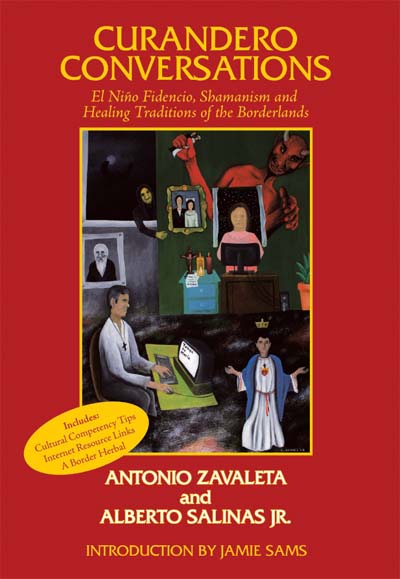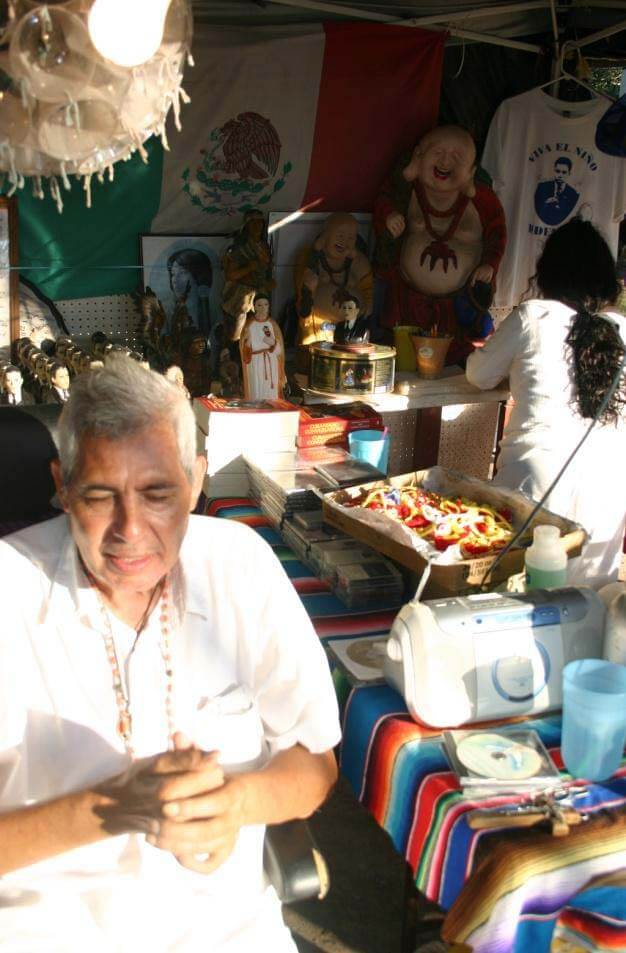Texas Standard - By W.F. Strong, April 21, 2021 Don Pedrito never took credit for cures.…
Curanderismo And The Role Of Cultural Competency In The Delivery Of Latino Health Care
Dr. Antonio Zavaleta Associate Provost and Professor of Anthropology – The University of Texas at Brownsville

Understanding Culture
Objective #1
Culture refers to all learned patterns of human behavior including language, thoughts, communications, actions, customs, beliefs, values, and institutions that people develop and hold in common.
Objective #2
Understanding the role that culture plays in a person’s life choices
• Children have to learn a culture through a process called enculturation
• Families and communities invest heavily in their children and people
• Cultural caregivers provide safety and nurturing
• Culture provides guidelines and a roadmap for life
• Culture establishes limits and boundaries for behavior
Objective #3
Understanding the role that culture plays in the healthcare delivery system
• More in-depth information
• Better communication of diagnosis and treatment
• Providers feel a greater sense of satisfaction with their work
• Providers become more connected to the community they serve
A clinician who is unfamiliar with the nuances of an individual’s cultural reality may incorrectly judge as psychopathology those “normal cultural variations” in behavior, belief, or experience that are accepted as normal in the individual’s culture.
For example:
Certain religious practices or beliefs such as hearing or seeing a deceased relative during bereavement may be misdiagnosed as manifestations of the psychotic disorder.
Culture can Benefit the Health Care Delivery Setting
• Create a good reputation in the cultural community
• Increase the use of preventive services
• Increase cost-effectiveness by decreasing return visits and client compliance
• Reduce potential liability through communication
• Engender mutual respect and trust
Objective #4
Understanding what is meant by Cultural Competency
Cultural competency refers to understanding the linguistic and specific culture-bound behaviors and attitudes of a person or group of people and the ability of professionals to effectively work in cross-cultural situations.
HR3962 “The Health Bill” page 1,210 SUBPART XII—PUBLIC HEALTH WORKFORCE
Subtitle D—Adapting Workforce to Evolving Health System Needs
PART 1—HEALTH PROFESSIONS TRAINING FOR DIVERSITY
Sec. 2243. Coordination of diversity and cultural competency programs.
PART 2—INTERDISCIPLINARY TRAINING PROGRAMS
Sec. 2251. Cultural and linguistic competency training for health professionals.
Objective # 5
Understand the Importance of Cultural Competency
• Perception of health and illness and its cause varies by culture
• Culture influences individual health care preferences and choices
• Culture dictates a person’s perception of the health care they received
• The socio-cultural environment influences cultural practices, beliefs and perceptions of health, illness and cure
• Health care providers from culturally and linguistically diverse groups are limited
A growing literature documents that there is as much of the “physical” in “mental” disorders as there is “mental” in “physical” disorders.
I have seen Belief kill and Faith Heal!
Culturally and Linguistically Appropriate Standards Federal Guidelines (CLAS 1-7)
- Culturally Appropriate care (Recommended)
- Implement strategies (Recommended)
- Staff on-going CE (Recommended)
- Provide language assistance (Mandated)
- Provide notice of language (Mandated)
- Competence of language (Mandated)
- Language appropriate material (Mandated)
- Have a strategic plan for Cultural Competencies (Recommended)
- Institutional assessment (Recommended)
- Collect data (Recommended)
- Demographic profile (Recommended)
- Partnerships (Recommended)
- Grievance resolution (Recommended)
- Make progress available (Voluntary)
Use of Clinical Judgment: It is important that diagnosis not is applied mechanically. The exercise of clinical judgment may justify giving a certain diagnosis to an individual even though the clinical presentation falls just short of meeting the full criteria for the diagnosis as long as the symptoms that are present are persistent and severe.
Could there be another diagnosis?
Use of Clinical Judgment
The fact that an individual’s symptoms meet the criteria for a DSM-IV diagnosis does not carry any necessary implication regarding the individual’s degree of control over the behaviors that may be associated with the disorder. DSM-IV p. xxxiii
Inappropriate diagnosis can have very serious social and cultural implications!
Ethnic and Cultural Considerations
Diagnostic assessment can be especially challenging when a clinician from one ethnic or cultural group uses the DSM-IV classification to evaluate an individual from a different ethnic or cultural group.
Should there be a consultation within the context of culture?
DSM-IV includes three types of information specifically related to cultural considerations:
- A discussion of the cultural scenario and possible variations in the clinical symptoms of those disorders that have been included or not included in the DSM-IV classification.
- A description of culture-bound syndromes that have not been included in the DSM-IV classifications.
- An outline for cultural formulation designed to assist the clinician in systematically evaluating and reporting the impact of the individual’s cultural context and learning for next time.
Objective # 6
Understanding what is meant by Complimentary and Alternative Medicine (CAM)
CAM is a group of diverse medical and health care systems, practices, and products that are not generally considered to be a part of conventional medicine.
Complementary used together with medicine.
Alternative used in place of medicine integrative medicine combines conventional with CAM.
Culture-Bound Syndromes
• Ataque de nervios
• Bilis and colera or muina
• Locura
• Mal de Ojo
• Nervios
• Spell or Trabajo
• Susto
• Zar or Spirit Possession
Objective #7
Understanding the importance of CAM for LatinosConditions Frequently Presented to Curanderos for Treatment
• 300.14 Dissociative Identity Disorder
• 302.81 Fetishism
307.47 Nightmare Disorder
•301.0 Paranoid Personality Disorder
Conditions Frequently Presented to Curanderos for Treatment
•302.22 Schizotypal Personality Disorder
•301.7 Antisocial Personality Disorder
•301.83 Borderline Personality Disorder
•301.50 Histrionic Personality Disorder
•301.81 Narcissistic Personality Disorder
•301.82 Avoidant Personality Disorder
Conditions Frequently Presented to Curanderos for Treatment
•301.4 Dependent Personality Disorder
•301.9 Personality Disorder
•301.20 Schizoid Personality Disorder
•V62.89 Religious or Spiritual Problem
•V62.4 Acculturation Problem
• Dissociative Trance Disorder
Objective #8
Understanding Curanderismo
• What is Curanderismo?
• Who are Curanderos/ as?
• How does one become a Curandero/ a?
• What are the sub-specialties?
• Where does curanderismo come from?
• Is Curanderismo widespread?
• What role does religious belief play?
• Is Curanderismo real or fake?
• Is Curanderismo against the law?
• Is Curanderismo dying out?
• How is Curanderismo changing?
• Do people still believe in and practice?
• Do children believe in curanderismo ?
• What does official religion say about it?
• Is curanderismo just for the poor and uneducated?
• Why should we know about it?
Objective # 9
Understanding the role of the Curandero
• A curandero/a is a respected and revered member of the locally-based community
• A curandero/a is an essential member of the healthcare team in the community
• The curandero/a is the first person contacted when there is a family crisis
• Neighborhood members form a network with the curandero/a who in turn connects with the external official community
• Lifelong bonds are formed between curandero/a and locally-based community members
• The curandero/a is an indispensable resource in the locally-based community
Curandero CuranderismoSyndromes:
• Material practice-Herbs and Physical Things
• Spiritual Practice-Concentration or Trance State
• Susto-Fright Sickness
• Mal de Ojo-The Evil Eye
• MolleraCaida –Fallen Fontanel
• Empacho, Cólico and Latido-Upset Stomach
• Muina, Chipil, Coraje-Anger, Fits
• Resfriados-Colds and Fevers
• Parche-Poultice
• Ronchasand Granos-Skin Problems/Infections
• Envidia and Celos-Envy and Jealousy
• Nervios-Nervous Condition
• Asustado-Scared
• Mal de Aire-Bad Air
• Mala Vibración-Bad Vibes or Negative Energy
The Rituals:
• Limpia or Barrida-the ritual sweeping
• The laying on of hands
• Healing with fresh herbs
• Healing with a fertile hen’s egg
• Recitation of prayer or benediction
• Votive Candle burning
• The Santoral propitiation of Saint and entities
• Use of Amulets and Talismans for protection
• Anointing with oils
• Despojo with prepared waters
• Sacred counseling
• Sacred writing on paper
• Use of photographs and figures
• Cleansing of evil with burning or fire
• Exorcism or casting out evil spirits and demons
Curanderos and Spiritual Entities
The Living Curanderos/as
In your town and neighborhood
The Deceased Curanderos/as
Don Pedrito Jaramillo
El Niño Fidencio
Teresita Urrea
Maria Sabina
Pachita
The Catholic Saints and Virgins
Santa Maria de Guadalupe
San Francisco
San Judas, and many more
The Spirit Entities
Pancho Villa
Mal Verde
La Santisima Muerte
Santeria Orishias
Deceased Doctors, Indians, Gypsies
And many other spirits
Spiritual Precincts and Sacred Places
Objective # 10
How can CuranderoConversations help you?
“Curandero Conversations” is the most comprehensive book on curanderismo on the market today
“Curandero Conversations” depicts real-life cases and was written with the practitioner in mind
“Curandero Conversations” is broken down into easily accessible sections each dealing with real-life situations, Healing the Workplace: The Treacherous World Beyond the Home
“Curandero Conversations” Offers a complete breakdown of Federal guidelines on Cultural Competency and more
“Curandero Conversations” Offers hundreds of internet links and other references for further research
“Curandero Conversations” Has the complete listing of medicinal plants in English and Spanish in existence
